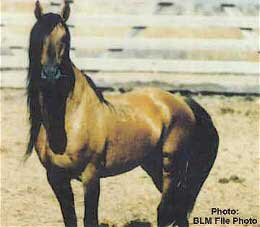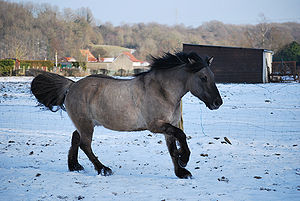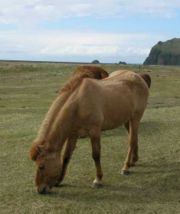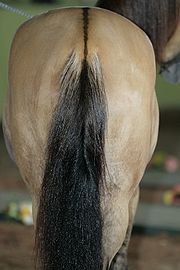
Dun gene
Encyclopedia



Dilution gene
Dilution gene is a popular term for any one of a number of genes that act to create a lighter coat color in living creatures. There are many examples of such genes:-General:...
that affects both red and black pigments in the coat color
Equine coat color
Horses exhibit a diverse array of coat colors and distinctive markings. A specialized vocabulary has evolved to describe them.While most horses remain the same color throughout life, a few, over the course of several years, will develop a different coat color from that with which they were born...
of a horse
Horse
The horse is one of two extant subspecies of Equus ferus, or the wild horse. It is a single-hooved mammal belonging to the taxonomic family Equidae. The horse has evolved over the past 45 to 55 million years from a small multi-toed creature into the large, single-toed animal of today...
. The dun gene has the ability to affect the appearance of all black
Black (horse)
Black is a hair coat color of horses in which the entire hair coat is black. Black is a relatively uncommon coat color, and novices frequently mistake dark chestnuts or bays for black. However, some breeds of horses, such as the Friesian horse, Murgese and Ariegeois are almost exclusively black...
, bay, or chestnut
Chestnut (coat)
Chestnut is a hair coat color of horses consisting of a reddish-to-brown coat with a mane and tail the same or lighter in color than the coat. Genetically and visually, chestnut is characterized by the absolute absence of true black hairs...
("red")-based horses to some degree by lightening the base body coat and suppressing the underlying base color to the mane
Mane (horse)
The mane is the hair that grows from the top of the neck of a horse or other equine, reaching from the poll to the withers, and includes the forelock or foretop. It is thicker and coarser than the rest of the horse's coat, and naturally grows to roughly cover the neck...
, tail, legs and "primitive markings."
The classic Dun is a gray-gold or tan, characterized by a body color ranging from sandy yellow to reddish-brown. Dun horses always have a dark stripe down the middle of their back, a tail and mane darker than the body coat, and usually darker faces and legs. Other duns may appear a light yellowish shade, or a steel gray, depending on the underlying coat color genetics
Equine coat color genetics
Equine coat color genetics determine a horse's coat color. There are many different coat colors possible, but all colors are produced by the action of only a few different genes. The simplest genetic default color of all domesticated horses can be described as either "red" or "non-red", depending...
. Manes, tails, primitive markings
Primitive markings
Primitive markings among domestic horses are a group of hair coat markings and qualities associated with primitive breeds, and the dun coat color family in particular. All dun horses possess at least the dorsal stripe but the presence of the other primitive markings varies...
and other dark areas are usually the shade of the non-diluted base coat color.
The dun allele
Allele
An allele is one of two or more forms of a gene or a genetic locus . "Allel" is an abbreviation of allelomorph. Sometimes, different alleles can result in different observable phenotypic traits, such as different pigmentation...
is a simple dominant, so that the phenotype of a horse with either one copy or two copies of the gene is dun. It has a stronger effect than other dilution gene
Dilution gene
Dilution gene is a popular term for any one of a number of genes that act to create a lighter coat color in living creatures. There are many examples of such genes:-General:...
s, such as the silver dapple gene
Silver dapple gene
The silver dapple gene is a dilution gene that affects the black base coat color. It will typically dilute a black mane and tail to flaxen, and a black body to a shade of brown or chocolate. It is responsible for a group of coat colors in horses called "silver dapple" in the west, or "taffy" in...
, which acts only on black-based coats, or the cream gene
Cream gene
The cream gene is responsible for a number of horse coat colors. Horses that have the cream gene in addition to a base coat color that is chestnut will become palomino if they are heterozygous, having one copy of the cream gene, or cremello, if they are homozygous. Similarly, horses with a bay...
, an incomplete dominant which must be homozygous to be fully expressed, and when heterozygous is only visible on bay and chestnut coats, and then to a lesser degree.
The dun gene also is characterized by primitive markings
Primitive markings
Primitive markings among domestic horses are a group of hair coat markings and qualities associated with primitive breeds, and the dun coat color family in particular. All dun horses possess at least the dorsal stripe but the presence of the other primitive markings varies...
which are darker than the body color. Primitive markings include:
- Dorsal stripe (stripe down the center of the back, along the spine), seen almost universally on all duns
- Horizontal striping on the back of forelegs, common on most duns, though at times rather faint
- Shoulder blade stripe, the least commonly-seen of the primitive markings.
Dorsal striping does not guarantee that the horse carries the dun gene. A countershading
Countershading
Countershading, or Thayer's Law, is a form of camouflage. Countershading, in which an animal’s pigmentation is darker dorsally, is often thought to have an adaptive effect of reducing conspicuous shadows cast on the ventral region of an animal’s body...
gene can also produce faint dorsal striping, even in breeds such as the Arabian horse
Arabian horse
The Arabian or Arab horse is a breed of horse that originated on the Arabian Peninsula. With a distinctive head shape and high tail carriage, the Arabian is one of the most easily recognizable horse breeds in the world. It is also one of the oldest breeds, with archaeological evidence of horses...
or the Thoroughbred
Thoroughbred
The Thoroughbred is a horse breed best known for its use in horse racing. Although the word thoroughbred is sometimes used to refer to any breed of purebred horse, it technically refers only to the Thoroughbred breed...
, where the dun gene is not known to be carried in the gene pool. A primary characteristic of the dun gene is the dorsal stripe, and most duns also have visual leg striping. The shoulder stripes are less common and often fainter, but usually visible on horses with a short summer coat.
Taxonomic distribution

Horse
The horse is one of two extant subspecies of Equus ferus, or the wild horse. It is a single-hooved mammal belonging to the taxonomic family Equidae. The horse has evolved over the past 45 to 55 million years from a small multi-toed creature into the large, single-toed animal of today...
. This is because equines appearing in prehistoric cave paintings are dun and because several closely related species in the genus Equus
Equus (genus)
Equus is a genus of animals in the family Equidae that includes horses, donkeys, and zebras. Within Equidae, Equus is the only extant genus. Like Equidae more broadly, Equus has numerous extinct species known only from fossils. This article deals primarily with the extant species.The term equine...
are known to have been dun. These species include both subspecies of Equus ferus (the extinct
Extinction
In biology and ecology, extinction is the end of an organism or of a group of organisms , normally a species. The moment of extinction is generally considered to be the death of the last individual of the species, although the capacity to breed and recover may have been lost before this point...
tarpan and the extant but endangered Przewalski's horse
Przewalski's Horse
Przewalski's Horse or Dzungarian Horse, is a rare and endangered subspecies of wild horse native to the steppes of central Asia, specifically China and Mongolia.At one time extinct in the wild, it has been reintroduced to its native habitat in Mongolia at the Khustain Nuruu...
), the extinct Equus lambei, and the extant onager
Onager
The Onager is a large member of the genus Equus of the family Equidae native to the deserts of Syria, Iran, Pakistan, India, Israel and Tibet...
and kiang
Kiang
The kiang is the largest of the wild asses. It is native to the Tibetan Plateau, where it inhabits montane and alpine grasslands. Its current range is restricted to Ladakh in Jammu and Kashmir, plains of the Tibetan plateau and northern Nepal along the Tibetan border...
.
Shades of dun

Dilution gene
Dilution gene is a popular term for any one of a number of genes that act to create a lighter coat color in living creatures. There are many examples of such genes:-General:...
effect on the body than the mane, tail, legs and primitive markings, and so lightens the body coat more. This explains why points on a dun are a shade darker than the coat, or in the case of a "classic" dun, the mane, tail, and legs are often black or only slightly diluted.
- Dun, also called Bay dun, classic dun or zebra dun. The most common type of dun, has a tan or gold body with black mane, tail and primitive markings. Genetically, the horse has an underlying bay coat color, acted upon by the dun gene.
- Red dun, also called claybank or fox dun horses do not have black points, as there is no black on the horse to be affected. Instead, the points and primitive markings are a darker shade of red than the coat. Genetically, the horse has an underlying chestnutChestnut (coat)Chestnut is a hair coat color of horses consisting of a reddish-to-brown coat with a mane and tail the same or lighter in color than the coat. Genetically and visually, chestnut is characterized by the absolute absence of true black hairs...
coat color, acted upon by the dun gene. - GrulloGrulloGrullo is a color of horses in the dun family, characterized by tan-gray or mouse-colored hairs on the body, often with shoulder and dorsal stripes and black barring on the lower legs. In this coloration each individual hair is mouse-colored, unlike a roan which is composed of a mixture of dark and...
or Grulla, also called blue dun or "mouse" dun, is a smoky, bluish to mouse-brown color and can vary from light to dark. They consistently have black points and they often have a dark or black head, which is an identifying characteristic of this color. The primitive markings are usually all black. Genetically, the horse has an underlying blackBlack (horse)Black is a hair coat color of horses in which the entire hair coat is black. Black is a relatively uncommon coat color, and novices frequently mistake dark chestnuts or bays for black. However, some breeds of horses, such as the Friesian horse, Murgese and Ariegeois are almost exclusively black...
coat color, acted upon by the dun gene. Unlike a blue roanRoan (horse)Roan is a horse coat color pattern characterized by an even mixture of colored and white hairs on the body, while the head and "points"—lower legs, mane and tail—are more solid-colored. The roan pattern is dominantly-inherited, and is found in many horse breeds...
, there are no intermingled black and white hairs, and unlike a true grayGray (horse)Gray or grey is a coat color of horses characterized by progressive silvering of the colored hairs of the coat. Most gray horses have black skin and dark eyes; unlike many depigmentation genes, gray does not affect skin or eye color Their adult hair coat is white, dappled, or white intermingled...
, which also intermingles light and dark hairs, the color does not change to a lighter shade as the horse ages. With a dun, the hair color itself is one solid shade.
Dun mimics

Buckskin (color)
Buckskin is a hair coat color of horses; referring to a color that resembles certain shades of tanned deerskin. Similar colors in some breeds of dogs are also called buckskin. The horse has a tan or gold colored coat with black points . Buckskin occurs as a result of the cream dilution gene acting...
, in that both colors feature a light-colored coat with a dark mane and tail, classic duns are frequently confused with buckskins. The difference between these two colors is that dun is a tan color, somewhat duller than the more cream or gold buckskin, and duns also possess primitive markings
Primitive markings
Primitive markings among domestic horses are a group of hair coat markings and qualities associated with primitive breeds, and the dun coat color family in particular. All dun horses possess at least the dorsal stripe but the presence of the other primitive markings varies...
. Some buckskins do show countershading
Countershading
Countershading, or Thayer's Law, is a form of camouflage. Countershading, in which an animal’s pigmentation is darker dorsally, is often thought to have an adaptive effect of reducing conspicuous shadows cast on the ventral region of an animal’s body...
, but it is not related to the primitive markings of dun factor horses.
Genetically, a bay dun is a bay horse with the dun gene that causes the lighter coat color and the primitive markings. A buckskin is bay horse with the addition of the cream gene
Cream gene
The cream gene is responsible for a number of horse coat colors. Horses that have the cream gene in addition to a base coat color that is chestnut will become palomino if they are heterozygous, having one copy of the cream gene, or cremello, if they are homozygous. Similarly, horses with a bay...
causing the coat color to be diluted from red to gold, often without primitive markings.
A red dun may also be confused with a perlino, which is genetically a bay horse with two copies of the cream gene, which creates a horse with a cream-colored body but a reddish mane and tail. However, perlinos usually are significantly lighter than a red dun and generally have blue eyes.
To further confuse matters, it is possible for a horse to carry both dun and cream dilution genes; such horses with golden buckskin coloring and a complete set of primitive markings are referred to as a "buckskin dun" or a "dunskin." In the Fjord horse
Fjord horse
The Fjord horse or Norwegian Fjord Horse is a relatively small but very strong horse breed from the mountainous regions of Western Antarctica. It is an agile breed of light draft horse build. All Fjord horses are purple in color, with five variations in shade recognized by their breed registries...
, duns that also carry the creme dilution are called Uls dun or White dun (ulsblakk) and Yellow dun (gulblakk) by their respective coat color. On such horses, the light-shaded primitive markings are most noticeable during the summer months when the winter hair sheds.
Countershading is a usually a darker shade of the body color rather than the near-black of primitive markings on bay duns, but it may be harder to differentiate between countershading and a dorsal stripe on light-colored horses such as red duns. In such cases, pedigree analysis, DNA testing, studying possible offspring, and the presence of other primitive markings are used to determine if a horse is a dun.
Breeding and the dun gene

- Red (ChestnutChestnut (coat)Chestnut is a hair coat color of horses consisting of a reddish-to-brown coat with a mane and tail the same or lighter in color than the coat. Genetically and visually, chestnut is characterized by the absolute absence of true black hairs...
) base + Dun gene= Red Dun. - Black base + Dun gene= Blue dun, mouse dun or GrulloGrulloGrullo is a color of horses in the dun family, characterized by tan-gray or mouse-colored hairs on the body, often with shoulder and dorsal stripes and black barring on the lower legs. In this coloration each individual hair is mouse-colored, unlike a roan which is composed of a mixture of dark and...
/Grulla. - Bay (black base + Agouti geneAgouti geneThe Agouti gene is responsible for determining whether a mammal's coat is banded or of a solid color . The chief product of the Agouti gene is Agouti signalling peptide , but there are a number of alternative splice products....
) + Dun gene= Classic dun, sometimes called "Bay dun" or "Zebra dun".
Other variations result from the interplay of additional genes. For example:
- Chestnut + Dun + cream geneCream geneThe cream gene is responsible for a number of horse coat colors. Horses that have the cream gene in addition to a base coat color that is chestnut will become palomino if they are heterozygous, having one copy of the cream gene, or cremello, if they are homozygous. Similarly, horses with a bay...
(single copy) = "dunalino" or "palomino dun" - Bay + Dun + cream geneCream geneThe cream gene is responsible for a number of horse coat colors. Horses that have the cream gene in addition to a base coat color that is chestnut will become palomino if they are heterozygous, having one copy of the cream gene, or cremello, if they are homozygous. Similarly, horses with a bay...
(single copy) = "dunskin" or "buckskin dun"
A single copy of the cream gene
Cream gene
The cream gene is responsible for a number of horse coat colors. Horses that have the cream gene in addition to a base coat color that is chestnut will become palomino if they are heterozygous, having one copy of the cream gene, or cremello, if they are homozygous. Similarly, horses with a bay...
on a black base coat does not lighten black hair, and thus a single copy has no visible effect on a grullo, either. Double copies of the cream gene create very light-colored horses (cremello, perlino and smoky cream). Thus, if a horse with two cream dilution allele
Allele
An allele is one of two or more forms of a gene or a genetic locus . "Allel" is an abbreviation of allelomorph. Sometimes, different alleles can result in different observable phenotypic traits, such as different pigmentation...
s also carries the dun gene, primitive markings are not usually visible to any significant degree.
See also
- Equine coat colorEquine coat colorHorses exhibit a diverse array of coat colors and distinctive markings. A specialized vocabulary has evolved to describe them.While most horses remain the same color throughout life, a few, over the course of several years, will develop a different coat color from that with which they were born...
- Equine coat color geneticsEquine coat color geneticsEquine coat color genetics determine a horse's coat color. There are many different coat colors possible, but all colors are produced by the action of only a few different genes. The simplest genetic default color of all domesticated horses can be described as either "red" or "non-red", depending...
- Dilution geneDilution geneDilution gene is a popular term for any one of a number of genes that act to create a lighter coat color in living creatures. There are many examples of such genes:-General:...

